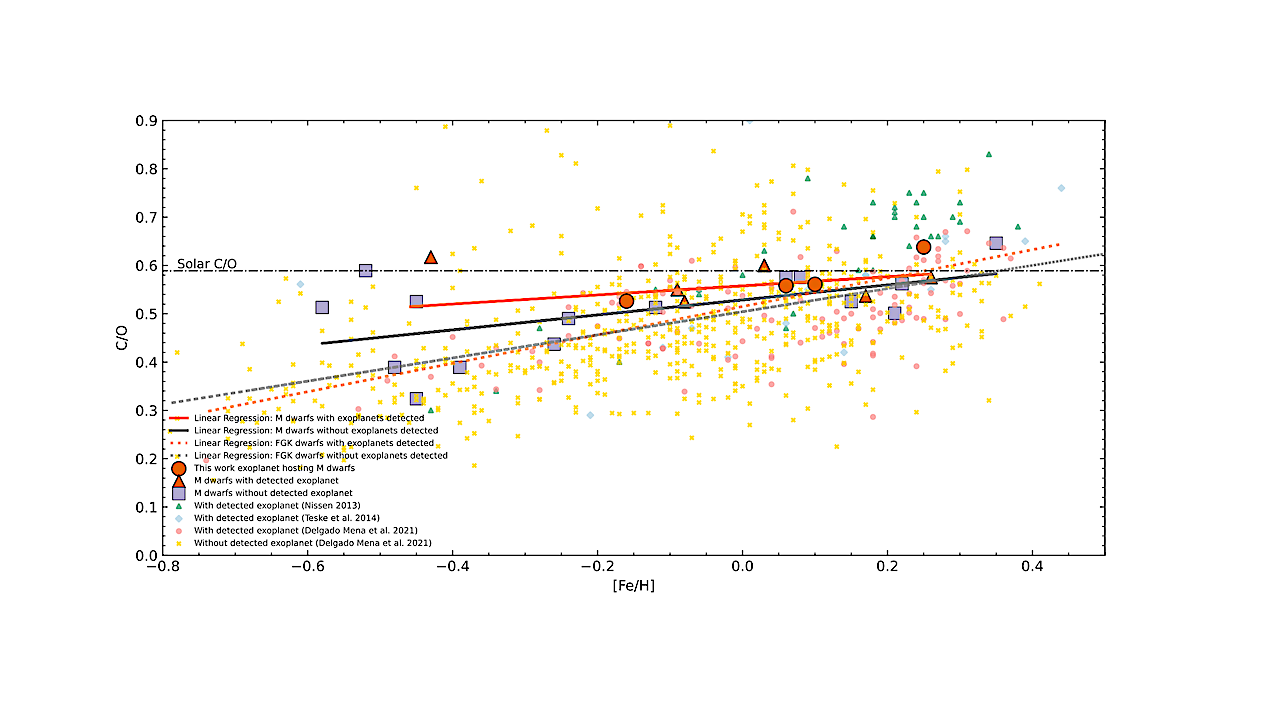Stellar Characterization and Chemical Abundances of Exoplanet Hosting M dwarfs from APOGEE Spectra: Future JWST Targets

Exoplanets hosting M dwarfs are the best targets to characterize Earth-like or super-Earth planetary atmospheres with the James Webb Space Telescope (JWST). We determine detailed stellar parameters (Teff, logg, and ξ) and individual abundances of twelve elements for four cool M dwarfs hosting exoplanets TOI-1685, GJ 436, GJ 3470, and TOI-2445, scheduled for future observations by the JWST.
The analysis utilizes high-resolution near-infrared spectra from the SDSS-IV APOGEE survey between 1.51-1.69μ. Based on 1D-LTE plane-parallel models, we find that TOI-2445 is slightly metal-poor ([Fe/H] = -0.16±0.09), while TOI-1685, GJ 436 and GJ 3470 are more metal-rich ([Fe/H] = 0.06±0.18, 0.10±0.20 dex, 0.25±0.15). The derived C/O ratios for TOI-2445, TOI-1685, GJ 436, and GJ 3470 are 0.526±0.027, 0.558±0.097, 0.561±0.029, and 0.638±0.015, respectively.
From results for 28 M dwarfs analyzed homogeneously from APOGEE spectra, we find exoplanet-hosting M dwarfs exhibit a C/O abundance ratio approximately 0.01 to 0.05 higher than those with non-detected exoplanets, at limits of a statistically significant offset. A linear regression of [Fe/H] \textit{vs.} C/O distribution reveals a noticeable difference in the angular coefficient between FGK dwarfs (0.27) and M dwarfs (0.13). Assuming our abundance ratios of Ca/Mg, Si/Mg, Al/Mg, and Fe/Mg, we determine a mass of 3.276+0.448−0.419M⊕ for TOI-2445 b, having density (6.793+0.005−0.099 this http URL−3) and core mass fraction (0.329+0.028−0.049) very similar to Earth’s.
We also present an atlas of 113 well-defined spectral lines to analyze M dwarfs in the H-band and a comprehensive evaluation of uncertainties from variations in the atmospheric parameters, signal-to-noise, and pseudo-continuum.
Edypo Melo, Diogo Souto, Katia Cunha, Verne V. Smith, Fábio Wanderley, Vinicius Grilo, Deusalete Camara, Kely Murta, Neda Hejazi, Ian J.M. Crossfield, Johanna Teske, Rafael Luque, Michael Zhang, Jacob Bean
Comments: 32 pages, 3 figures. Accepted to the Astrophysical Journal (ApJ)
Subjects: Solar and Stellar Astrophysics (astro-ph.SR); Earth and Planetary Astrophysics (astro-ph.EP)
Cite as: arXiv:2406.00111 [astro-ph.SR] (or arXiv:2406.00111v1 [astro-ph.SR] for this version)
https://doi.org/10.48550/arXiv.2406.00111
Focus to learn more
Submission history
From: Édypo Ribeiro De Melo
[v1] Fri, 31 May 2024 18:03:06 UTC (254 KB)
https://arxiv.org/abs/2406.00111
Astrobiology,








